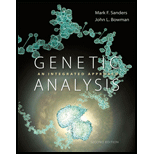
Concept explainers
To analyze:
Question asked for the description on the structure of bacterial chromosome and plasmid with their properties.
Introduction:
Bacteria mostly contain single, circular chromosomes or linear chromosomes with double stranded DNA sequences. Bacterial genome is haploid in nature and ranges between
Explanation of Solution
Escherichia coli and Bacillus subtilis are widely used bacterial species with single chromosome, among which E. coli is mostly used, and it has
Bacterial chromosome has little amount of repetitive DNA sequences in multiple copies at intergenic regions, though they rarely transcribe, they serve a key role in replication, recombination, or in regulation of transcription. In bacterial chromosome, chromosomes are densely packed in a series of tight loops in association with a number of nucleoid associated proteins (NAP), i.e. they show several loops by supercoiling of DNA. There are two types of associated proteins a) small nucleoid-associated proteins and b) structural maintenance of chromosomes proteins (SMC).
All aspects are determined.
Want to see more full solutions like this?
Chapter 11 Solutions
Genetic Analysis: An Integrated Approach Plus Mastering Genetics With Etext -- Access Card Package (2nd Edition)
- What are plasmids? What are sticky ends? What is the function of Ligase? DNA Gel electrophoresis is conducted on what principles? Write at least 3.arrow_forwardAside from resistance to multiple antibiotics, what other physiologic or metabolic functions are associated with plasmid DNA? Search from the internet important use of plasmids in Genetics and Molecular Biology? How do viruses and bacteria differ in terms of their genetic material?arrow_forwardExplain why the genes whose products are required for the normal growth of bacteria not carried on plasmids? Give two examples (one bacterial gene and one plasmid gene) to support your answer.arrow_forward
- During the process of protein synthesis on a ribosome, when the large ribosomal subunit covalently attaches an amino acid to a growing polypeptide, what is the name of this newly formed covalent bond? the phosphodiester bond the peptide bond the aminoacyl bond the ether bond the glycosidic bond The ability of F+ cells, or Hfr cells, to transfer plasmid DNA to an F- cell is properly called: transversion transformation conjugation transduction transitionarrow_forwardDescribe a mechanism by which a gene could movefrom the bacterial genome to a plasmid in the samecell, or vice versa.arrow_forwardA plasmid differs from the bacterial chromosome in that it is __________. A. significantly smaller B. always found as a single copy of DNA in a cell C. circular D. double-stranded A. significantly smaller B. always found as a single copy of DNA in a cell C. circular D. double-strandedarrow_forward
 Human Anatomy & Physiology (11th Edition)BiologyISBN:9780134580999Author:Elaine N. Marieb, Katja N. HoehnPublisher:PEARSON
Human Anatomy & Physiology (11th Edition)BiologyISBN:9780134580999Author:Elaine N. Marieb, Katja N. HoehnPublisher:PEARSON Biology 2eBiologyISBN:9781947172517Author:Matthew Douglas, Jung Choi, Mary Ann ClarkPublisher:OpenStax
Biology 2eBiologyISBN:9781947172517Author:Matthew Douglas, Jung Choi, Mary Ann ClarkPublisher:OpenStax Anatomy & PhysiologyBiologyISBN:9781259398629Author:McKinley, Michael P., O'loughlin, Valerie Dean, Bidle, Theresa StouterPublisher:Mcgraw Hill Education,
Anatomy & PhysiologyBiologyISBN:9781259398629Author:McKinley, Michael P., O'loughlin, Valerie Dean, Bidle, Theresa StouterPublisher:Mcgraw Hill Education, Molecular Biology of the Cell (Sixth Edition)BiologyISBN:9780815344322Author:Bruce Alberts, Alexander D. Johnson, Julian Lewis, David Morgan, Martin Raff, Keith Roberts, Peter WalterPublisher:W. W. Norton & Company
Molecular Biology of the Cell (Sixth Edition)BiologyISBN:9780815344322Author:Bruce Alberts, Alexander D. Johnson, Julian Lewis, David Morgan, Martin Raff, Keith Roberts, Peter WalterPublisher:W. W. Norton & Company Laboratory Manual For Human Anatomy & PhysiologyBiologyISBN:9781260159363Author:Martin, Terry R., Prentice-craver, CynthiaPublisher:McGraw-Hill Publishing Co.
Laboratory Manual For Human Anatomy & PhysiologyBiologyISBN:9781260159363Author:Martin, Terry R., Prentice-craver, CynthiaPublisher:McGraw-Hill Publishing Co. Inquiry Into Life (16th Edition)BiologyISBN:9781260231700Author:Sylvia S. Mader, Michael WindelspechtPublisher:McGraw Hill Education
Inquiry Into Life (16th Edition)BiologyISBN:9781260231700Author:Sylvia S. Mader, Michael WindelspechtPublisher:McGraw Hill Education





